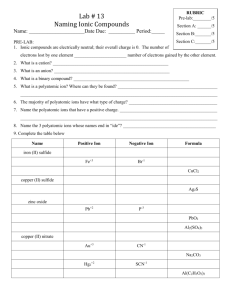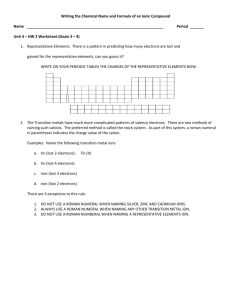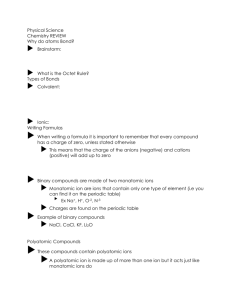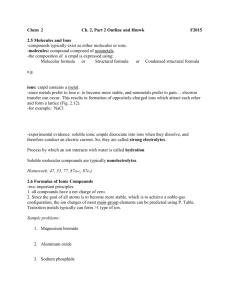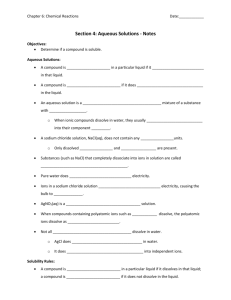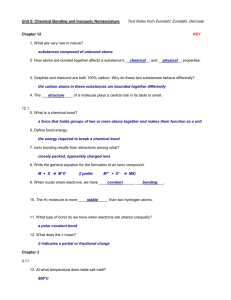Naming Chemical Compounds
advertisement
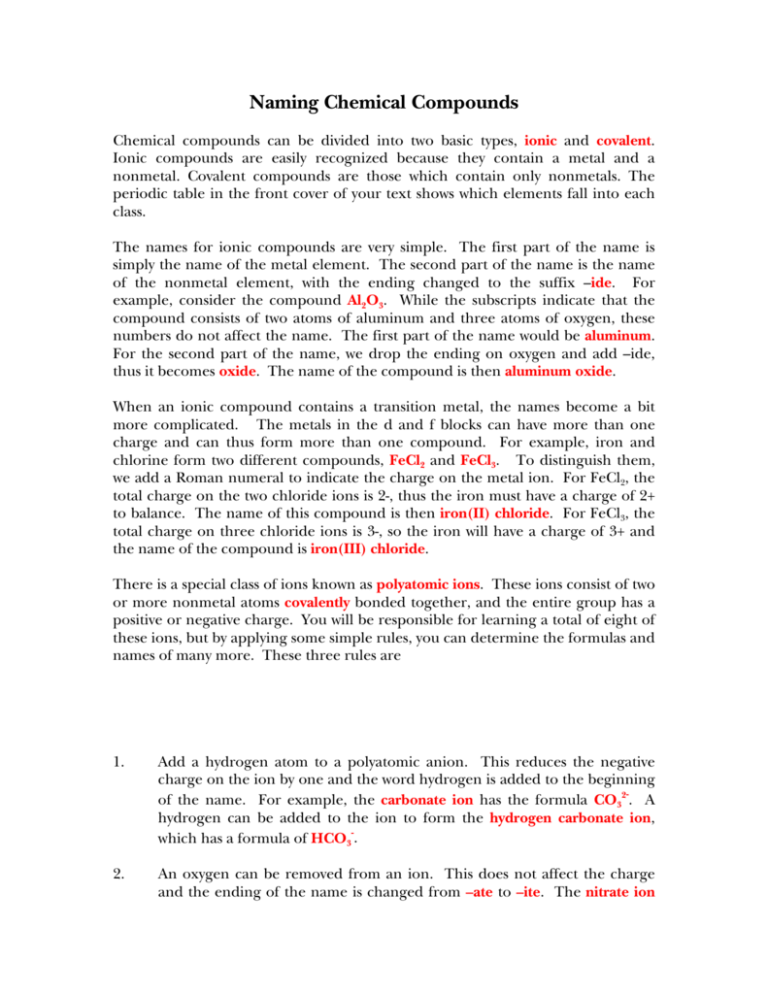
Naming Chemical Compounds Chemical compounds can be divided into two basic types, ionic and covalent. Ionic compounds are easily recognized because they contain a metal and a nonmetal. Covalent compounds are those which contain only nonmetals. The periodic table in the front cover of your text shows which elements fall into each class. The names for ionic compounds are very simple. The first part of the name is simply the name of the metal element. The second part of the name is the name of the nonmetal element, with the ending changed to the suffix –ide. For example, consider the compound Al2O3. While the subscripts indicate that the compound consists of two atoms of aluminum and three atoms of oxygen, these numbers do not affect the name. The first part of the name would be aluminum. For the second part of the name, we drop the ending on oxygen and add –ide, thus it becomes oxide. The name of the compound is then aluminum oxide. When an ionic compound contains a transition metal, the names become a bit more complicated. The metals in the d and f blocks can have more than one charge and can thus form more than one compound. For example, iron and chlorine form two different compounds, FeCl2 and FeCl3. To distinguish them, we add a Roman numeral to indicate the charge on the metal ion. For FeCl2, the total charge on the two chloride ions is 2-, thus the iron must have a charge of 2+ to balance. The name of this compound is then iron(II) chloride. For FeCl3, the total charge on three chloride ions is 3-, so the iron will have a charge of 3+ and the name of the compound is iron(III) chloride. There is a special class of ions known as polyatomic ions. These ions consist of two or more nonmetal atoms covalently bonded together, and the entire group has a positive or negative charge. You will be responsible for learning a total of eight of these ions, but by applying some simple rules, you can determine the formulas and names of many more. These three rules are 1. Add a hydrogen atom to a polyatomic anion. This reduces the negative charge on the ion by one and the word hydrogen is added to the beginning of the name. For example, the carbonate ion has the formula CO32-. A hydrogen can be added to the ion to form the hydrogen carbonate ion, which has a formula of HCO3-. 2. An oxygen can be removed from an ion. This does not affect the charge and the ending of the name is changed from –ate to –ite. The nitrate ion has the formula NO3-. The nitrite ion, NO2-, is formed by removing one oxygen atom from the nitrate. 3. The central atom in the ion can be exchanged with another element in the same group on the periodic table. The sulfate ion has the formula SO42-. The sulfur can be replaced by either selenium or tellurium, forming a selenate ion, SeO42- or a tellurate ion, TeO42-. Not all polyatomic ions can undergo all three of these changes. Carbonate ions can add a hydrogen, but cannot lose oxygen or switch with another element in Group IVA. Nitrate ions can lose an oxygen, but cannot add a hydrogen or switch with an element in Group VA. Phosphate ions, PO43-, and sulfate ions can do all three. A complete list of the polyatomic ions you need to know are listed below. The eight major ions are shown in bold, with the related ions for each shown below them. 1. Carbonate Hydrogencarbonate CO32HCO3- 2. Nitrate Nitrite NO3NO2- 3. Hydroxide OH- 4. Acetate C2H3O2- 5. Ammonium NH4+ 6. Sulfate Hydrogensulfate Sulfite Hydrogensulfite Selenate Hydrogenselenate Selenite Hydrogenselenite SO42HSO4SO32HSO3SeO42HSeO4SeO32HSeO3- 7. Phosphate Hydrogenphosphate Dihydrogenphosphate Phosphite Hydrogenphosphite Dihydrogenphosphite PO43HPO42H2PO4PO33HPO32H2PO3- 8. Arsenate Hydrogenarsenate Dihydrogenarsenate Arsenite Hydrogenarsenite Dihydrogenarsenite AsO43HAsO42H2AsO4AsO33HAsO32H2AsO3- Chlorate Chlorite Hypochlorite Perchlorate Bromate Bromite Hypobromite Perbromate Iodate Iodite Hypoiodite Periodate ClO3ClO2ClOClO4BrO3BrO2BrOBrO4IO3IO2IOIO4- Like transition metal ionic compounds, nonmetal elements commonly form two or more covalent compounds. For example, carbon and oxygen form both CO and CO2. They can’t both be called carbon oxide, so we have to have a way of telling them apart. One of these is a highly toxic gas, while the other is used to carbonate beverages, so you certainly wouldn’t want to mix them up! To distinguish covalent compounds or molecules with more than one formula, prefixes are used to indicate how many atoms of each element are present. The prefixes commonly used are shown in the table below. Number of Atoms 1 2 3 4 5 6 7 8 Prefix Mono Di Tri Tetra Penta Hexa Hepta Octa For example, CO would be called carbon monoxide. The prefix mono is commonly left out of the name. The assumption is that no prefix means that there is only one of that atom. The mono prefix in carbon monoxide is used because it has been in common use since the early days of chemistry. The compound NO is simply called nitrogen oxide. CO2 is then carbon dioxide, N2S3 is dinitrogen trisulfide, PF5 is phosphorous pentasulfide, and so on. Elements are also named in this way, since they can exist in multiple forms, called allotropes. For example, oxygen is found in nature as both O2 and O3. While these two gases are commonly called oxygen and ozone, respectively, their official names are dioxygen and trioxygen. Sample Problems 1. Write the name for Cu(NO2)2. Since the nitrite ion has a charge of 1-, the total negative charge is 2-. Thus, copper has a 2+ charge and the name is copper(II) nitrite. 2. Write the formula for aluminum sulfite. The two ions in this compound are Al3+ and SO32-. To balance the charges, two aluminum ions and three sulfite ions will be required. Thus, the formula will be Al2(SO3)2. Remember that parentheses must be use if there is more than one of the polyatomic ion. 3. Write the formula for tetraphosphorus hexoxide. Since the prefix tetra means 4 and hexa means 6, the formula is P4O6. 4. Write the formula for calcium dihydrogenarsenite. The two ions in this compound are Ca2+ and H2AsO3-. To balance the charges, two anions will be needed to balance the cation. Thus the formula will be Ca(H2AsO3)2. 5. Write the name for Au(IO)3. The hypoiodite ion has a 1- charge, so gold will have a 3+ charge to balance the three anions. Thus the name will be gold(III) hypoiodite.
